Abstract
We developed a new method for replicating psychedelic tracer effects in detail: the Tracer Replication Tool. This tool gives us a window into how the time-like texture of experience determines the state of consciousness we find ourselves in, which clarifies what makes both meditating and taking psychedelics such powerful state-switching activities. We discuss how the technique of using the tracer tool may find useful applications, such as allowing us to describe exotic “ineffable” experiences in clear language, standardize a scale of intensity of psychedelic drug effects (a.k.a. a “High-O-Meter”), help us quantify the synergy between different drugs, and test theories for what makes an experience feel good or bad such as the Symmetry Theory of Valence. The pilot data collected with this tool so far is suggestive of the following patterns: (1) THC and HPPD result in a smooth and faint trail effect. (2) The characteristic frequencies of the strobe and replay effects for 2C-B are slower than those of either DMT or 5-MeO-DMT. And, (3) whereas DMT comes with a strong color pulsing effect leading to very colorful visuals, 5-MeO-DMT gives rise to monochromatic tracer effects. We conclude by discussing the implications of these patterns in light of an analysis of experience that allows for a varying time-like texture. We hope to inspire the scientific community and curious psychonauts to use this tool to help us uncover more patterns.
Introduction
Rhythmic activity in the brain is a staple of neuroscience. It shows up in spiking neurons, synchronous oscillations at the level of networks, global patterns of resonance and coherence in EEG recordings, and in many other places. The book Rhythms of the Brain by György Buzsáki is a systematic review of what was known about these rhythms back in 20061 (Buzsáki 2006). One of the things György talks about in this book is how a lot of neuroscience techniques focused on finding the neural correlates of perception tend to consider the variable activation of neurons from one trial to the next as noise. In experiments that look into how neurons respond to a specific stimulus, datasets are constructed that track the neuronal activity that stays the same across trials. That which changes is discarded as noise, and György argues that such “noise” is really where the information about the internal rhythms is to be found2(Atasoy, Donnelly, and Pearson 2016). We concur with the assessment that understanding these native rhythms is key for making sense of how the brain works. Perhaps one of the most exciting developments in this space is the method of Connectome-Specific Harmonic Wave analysis(Atasoy, Donnelly, and Pearson 2016). This way of analyzing fMRI data describes a “brain state” as, at least partly, consisting of a weighted sum of its resonant modes. This paradigm has been used with success for comparing brain states across widely different categories of experience: LSD, ketamine, and anesthesia, among others(Luppi et al. 2020).
These are exciting times for exploring the native rhythms of nervous systems in neuroscience. But what about their subjective quality? One would hope that we could connect a formal third-person view of these rhythms with their experiential component. Alas, at this point in time the behavioral and physiological component of brain rhythms is far better understood than the way in which they cash out in subjective qualities.
Could there be a way to make these rhythms easily visible to ourselves as scientists? One interesting lens through which to see psychedelics is in terms of the way they excite specific rhythm-generating networks. This lens would present psychedelic states as giving you a sense of what it feels like to have many of these rhythms simultaneously activated, thus having access to a wider repertoire of brain states(Atasoy et al. 2017).
But you don’t need psychedelics to realize there’s something fishy about the solidity of our perception. Intuitively, one may get the impression that normal everyday states of consciousness do not show the signatures of being the result of ensembles of rhythmic activity. That said, some would affirm that paying attention to the artifacts of our perception may in fact be a window into these rhythms. For example, Lehar’s Harmonic Resonance Theory of the gestalt properties of perception(Steve Lehar 1999) attempts to explain the characteristics of well known visual illusions (such as the Kanizsa triangle) with principles derived from the superposition of rhythmic activity.
But you don’t need psychedelics to realize there’s something fishy about the solidity of our perception. Intuitively, one may get the impression that normal everyday states of consciousness do not show the signatures of being the result of ensembles of rhythmic activity. That said, some would affirm that paying attention to the artifacts of our perception may in fact be a window into these rhythms. For example, Lehar’s Harmonic Resonance Theory of the gestalt properties of perception (Lehar, 1999) attempts to explain the characteristics of well known visual illusions (such as the Kanizsa triangle) with principles derived from the superposition of rhythmic activity.
Paying close attention to the act of observing an object over time has led some researchers to play with the idea that our experience of the world is best understood as music(Lloyd 2013), for our feeling of a solid surrounding results from the interplay between finely coordinated sensations and acts of interpretation. Indeed, the fluidity of sensory impressions betrays our common-sense notion that we experience a solid and stable world. It often takes a perturbation out of our normal everyday state of consciousness to notice this. As an example here, we can point out that insight meditation practices peer into the illusion of solidity and continuity of our experience, whereas concentration meditation enhances these illusions(Ingram 2018).
Arguably, like a fish who cannot notice water until it’s taken out of it, the stitching process by which our brain constructs reality is usually hidden from view. To be taken out of the water in this context would be to be in a state that allows you to notice the seams of one’s experience. To the extent that this normal stitching process breaks down in exotic states of consciousness, they are clearly useful for research in this domain. Thus we argue that the artifacts of perception in alien states of consciousness are not noise; they provide hints for how normal experience is constructed. In particular, we posit that “psychedelic tracers” (i.e. the cluster of persisting visual phenomena caused by hallucinogens) may be a window into how rhythmic feedback dynamics are used to control the content of our experience. For this reason, we have been interested in turning what until now has been qualitative descriptions and informal approximations of this phenomenon into concrete quantitative replications.
In what follows we will showcase the value of a psychophysics toolkit we developed at the Qualia Research Institute called the Tracer Replication Tool for modeling psychedelic tracer phenomenology. Although we will focus on psychedelic experiences, this tool can have a much broader set of applications. For example, we show how the tool can be used to visualize and quantify the severity of HPPD, which currently has a very qualitative, and imprecise at best, diagnostic criteria. Likewise, the tool has the potential to bring together the complex clinical presentation of visual disturbances such as palinopsia, photopsia, oscillopsia, visual snow, and other conditions, into a coherent framework. Perhaps, speculatively, the connection between all these visual disturbances is to be found in the dysregulation of the rhythms of the visual control systems, which is what the tracer tool sets out to quantify.
There is only attempt of arriving at quantitative replications of psychedelic tracers in the scientific literature we are aware of(Dubois and VanRullen 2011). They used multiple-exposure stroboscopic photography in order to depict video scenes. They then asked many people who have had LSD experiences to identify the strobe frequency that best approximated their tracers (which on average was in the 15-20 Hz range).
As we will see, our model for psychedelic tracers is more detailed: it has multiple persistence of vision effects that combine together into a complex tracer. For this reason, the kind of tracers used in Dubois & VanRullen turn out to be a special case of our tool, which we call the strobe effect:
LSD users perceive a series of discrete positive afterimages in the wake of moving objects, a percept that has been likened to a multiple-exposure stroboscopic photograph, somewhat akin to Etienne-Jules Marey’s chronophotographs [5] from 1880, or to more recent digital art produced in a few clicks (Figure 1).
– Visual Trails: Do the Doors of Perception Open Periodically? by Dubois & VanRullen

By using a wider set of effects, the Tracer Replication Tool might give us hints about how psychedelics disrupt native rhythms given how they affect the processing of perceptual information at a granular level.
Before we provide the full set of tracer effects along with their associated vocabulary, let us jump into the preliminary psychedelic replications we have obtained thanks to this tool.
Psychedelic Replications
Over the years since I’ve run the Qualia Computing blog, I’ve received many messages from people who, for lack of a better term, we could call rational psychonauts. This should not be too surprising, with pieces like “How to Secretly Communicate with People on LSD” and “5-MeO-DMT vs. N,N-DMT: The 9 Lenses,” the site has become a bit of a Schelling point for people who like to blend computational reasoning and the study of exotic states of consciousness. These rational psychonauts are people who not only are well acquainted with exotic states of consciousness, but also like to use a scientific and rational lens to make sense of such states. In particular, people in this cluster often ask me to send them experiments to try out next time they take a psychedelic substance. I certainly never encourage them to take drugs, but under the assumption they will do so anyway, I sometimes send them tasks to do. Thus, once we had a prototype for the tracer tool, I already had a set of more than willing anonymous pilot participants. I sent them the link to the tool along with some brief instructions. Namely:
Look at the ball for a few minutes in state X (where X can be any substance, meditation, etc.). Then as soon as you come down, try to fiddle with the parameters on the left until the simulated tracer looks as close as possible to how you experienced it in the state. When you are ready, simply click “submit parameters” and add info about what the state you were in was at the time. In the case of HPPD, just try your best to replicate the tracer (I know it gets confusing when we talk about the tracers of the simulated tracers, but try to ignore those and just replicate the tracer of the original input).
Without further ado, here are the resulting replications I received:
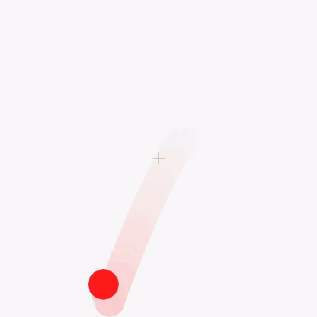




Notice how although the replication of the higher dosage is more mild in a way, they both share the presence of a strobe effect at roughly 5.5 Hz!

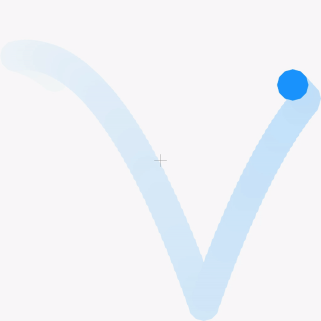
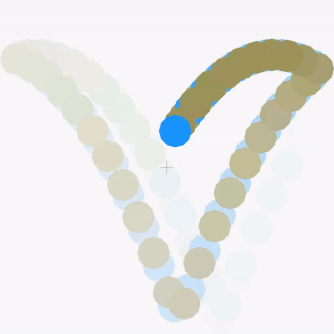
The higher dose has a complex mixture of effects, including 40 Hz color pulsing (positive and negative afterimages mixed together), 22 Hz replay, and 27 Hz strobe. I’ll note that the participant included the following comment: “Aside from extremely fast tracers, the white space consisted of pixelated fractals. Color was abundant.”
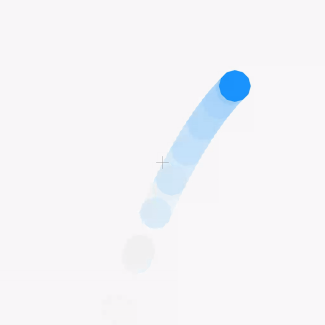
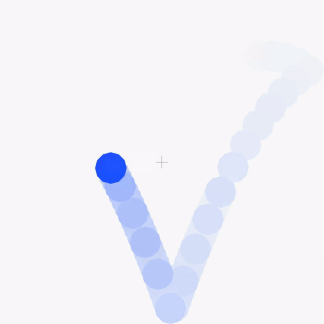
As we will discuss further below, it is worth noting that at least in this sample, there are no color pulsing effects present (which is unlike “regular” DMT).

The above is the only datapoint we have so far from the combination of psychoactive substances. The participant took 125μg of ETH-LAD, and then two and a half hours later 2 teaspoons of San Pedro powder. The replication is of the way the ball looked like 5 hours after taking the first drug.
Definitions
Core Effects
Core effects are pillars of the tracer tool where a particular feedback dynamic is used. The core effects include trails, strobe, and replay.
Modifiers
This is perhaps the most basic effect. Making an analogy with sound, trails are akin to a soft reverb with no delay:

The three settings for trails are: persistence, intensity, and exponential decay (which is binary in the current implementation and otherwise takes on the value of linear decay). Persistence determines how quickly the tracer vanishes, whereas intensity is a constant multiplier for the entire trail. Thus, by changing those parameters you can choose between e.g. a long but dim trail or a short but bright trail.
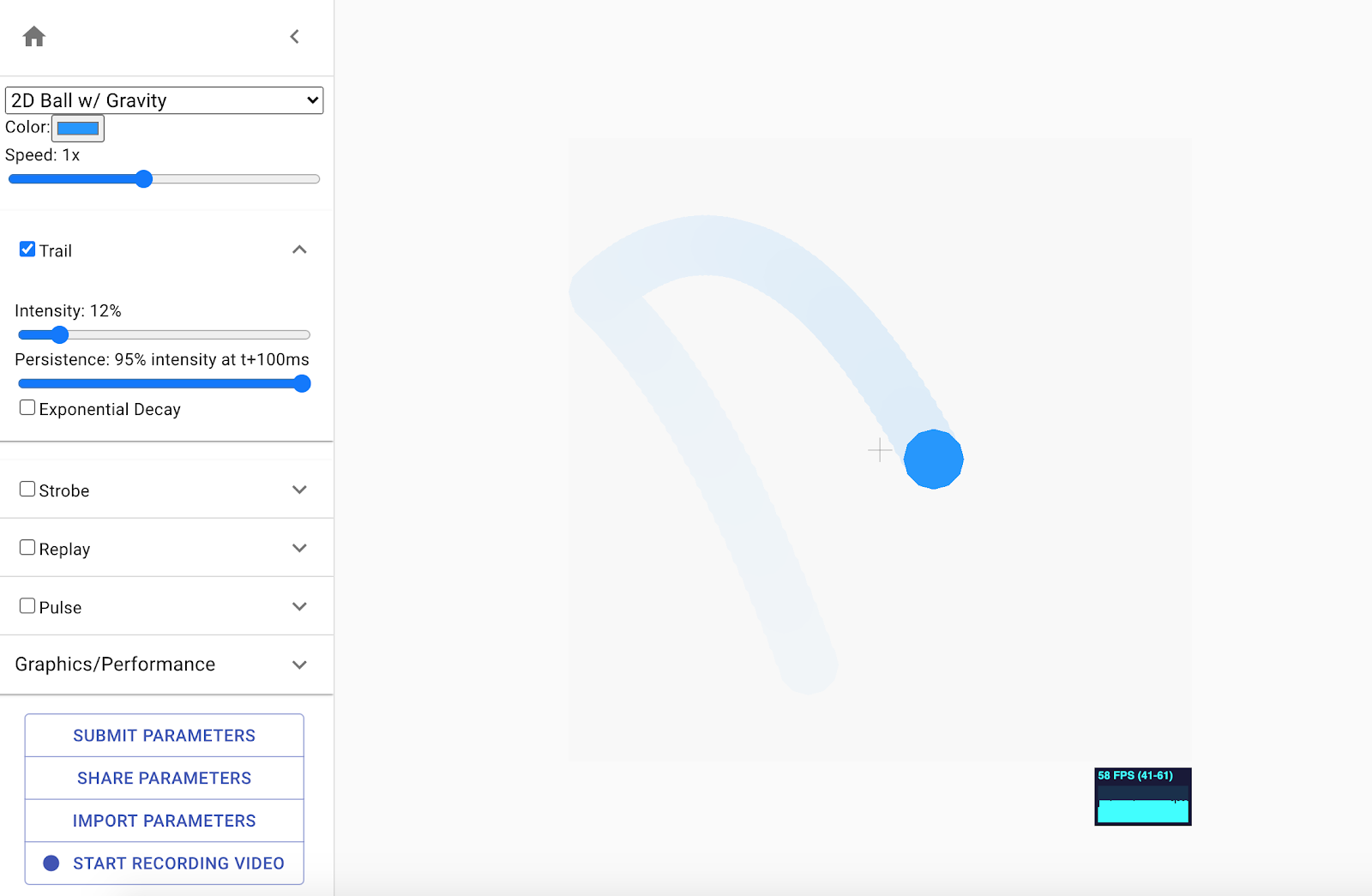
.png)
The exponential decay parameter slightly changes how quickly the brightness goes down; when it’s on, the trails go down more smoothly (cf. gamma correction).
.png)
.png)
Strobe (Core Effect)
The strobe effect takes snapshots of the input at regular intervals. It works like chronophotography, and it is perhaps what most people think about when you first talk about visual tracers. It is the effect that Dubois & VanRullen used to find that LSD produces visual tracers at ~15-20 Hz.
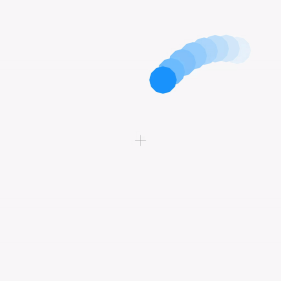
The strobe effect, just as the trail effect, also has intensity, persistence, and exponential decay modifiers. In addition, it also has frequency, which encodes how many snapshots per second are being taken.
.png)
.png)
.png)
Note: The current implementation of the trails feature is done with a very fast strobe. In this way, when you set the strobe frequency to the maximum you get something that starts to look a little like the trails effect.
Replay (Core Effect)
With an analogy to sound, replay would be akin to adding an echo or delay to a signal. Replay adds to the raw signal a copy of the output from a fraction of a second into the past. The result is a current output that contains a sequence of increasingly dimmer video replays of itself at regular time intervals into the past.

As with strobe, replay has intensity, persistence, exponential decay, and frequency as its modifying effects.
.png)
.png)
Note: the replay effect is difficult to distinguish from the strobe effect with only still images
Pulse (Modifier)
This is a modifier effect that can apply to trails, strobes, and replays (right now the implementation only applies to strobe, but we may change that in the future). It takes a fraction of the input and modulates it with a sine wave at a given frequency. This way the trails, strobes, and replays can come and go (either in part or in full) at a given frequency. This adds sparkle to the experience, and it can plausibly help create a sense of reality or object-permanence for the hallucinations as they “vibrate at their own frequency.”
Compare the difference between a strobe at 4 Hz vs. a strobe at 4 Hz with a pulse at 2 Hz:
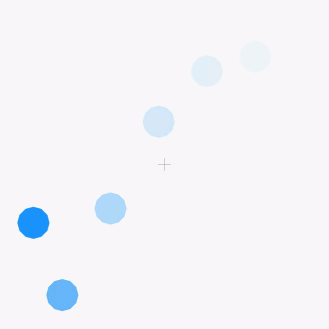
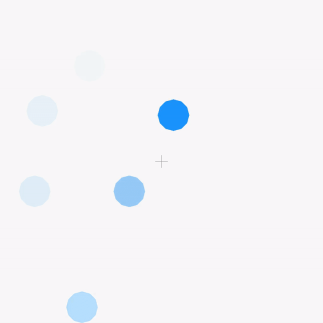
As you can see, the pulsing effect makes the strobes look like they have a sort of life of their own.
ADSR (Modifier)
This modifier effect was something we decided to add because James Kent of Psychedelic Information Theory(Kent 2010) talks about ADSR envelopes for tracers in the section titled “Control Interruption Model of Psychedelic Action”:
Using control interrupts as the source of hallucinogenesis, we can model hallucinogenic frame distortion of multisensory perception the same way we model sound waves produced by synthesizers; by plotting the attack, decay, sustain, and release (ADSR envelope) of the hallucinogenic interrupt as it effects consciousness. (Fig. 2)3,4 For example, nitrous oxide (N20) inhalation alters consciousness in such a way that all perceptual frames arise and fall with a predictable “wah-wah-wah” time signature. The throbbing “wah-wha-wah” of the N20 experience is a stable standing wave formation that begins when the molecule hits the neural network and ends when it is metabolized, but for the duration of N20 action the “wah-wah-wah” completely penetrates all modes of sensory awareness with a strobe-like intensity. The periodic interrupt of N20 can be modeled as a perceptual wave ambiguity that toggles back and forth between consciousness and unconsciousness at roughly 8 to 11 frames-per-second, or (8-11hz.5?) Consciousness rises at the peak of each “wah” and diminishes in the valleys in between. On sub-anesthetic doses, N20 creates a looping effect where frame content overlaps into the following frame, causing a perceptual cascade similar to fractal regression. We can thus model the interrupt envelope of N20 as having a rounded attack, fast decay, low sustain, medium release, with an interrupt frequency of (8-11hz?). Any psychoactive substance with a similar interrupt envelope will produce results that feel similar to the N20 experience. (Fig. 3) For instance, Smoked Salvia divinorum (vaporized Salvinorin A&B, or Salvia) has an interrupt envelope similar to N20, except Salvia has a harder attack, a slightly longer decay, a more intense sustain, a slightly longer release, and a slightly faster interrupt frequency ((12-15hz?)).6 These slight changes in the frequency and shape of interrupt envelope cause Salvia to feel more physically intense, more hallucinatory, and more disorienting than N20, even though they share a similar throbbing or tingling sensation along the same frequency range.
– The chapter about the Control Interrupt Model of Psychedelic Action in Psychedelic Information Theory by James L. Kent
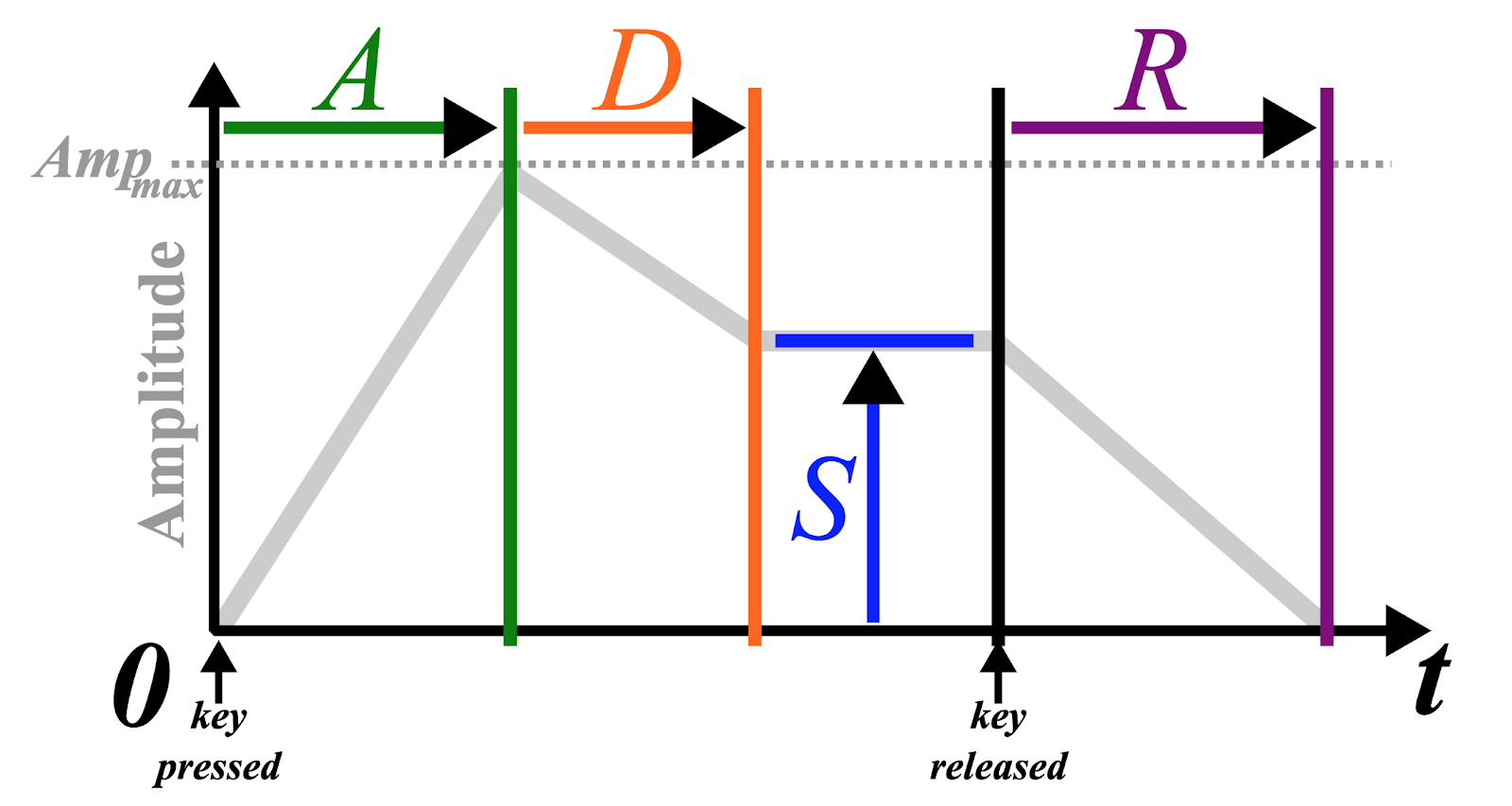
This actually seems to be important for showcasing what makes drugs with similar characteristic frequencies capable of feeling so different.
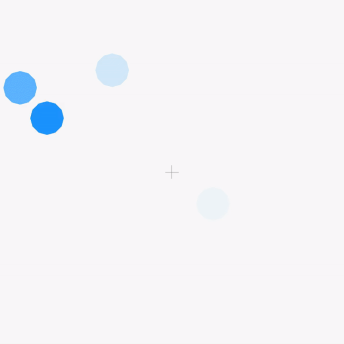

A really interesting research lead that is connected to the ADSR envelope of psychedelic tracers can be found in The Grand Illusion(Steven Lehar 2010), where cognitive scientist Steven Lehar narrates some of his experiences with LSD vs. LSD + MDMA. One of the things he discusses is the way that MDMA makes the experience jitter in a pleasant way that results in the LSD visuals becoming smoother (emphasis mine):
Under LSD and ecstasy I could see the flickering blur of visual generation most clearly. And I saw peculiar ornamental artifacts on all perceived objects, like a Fourier representation with the higher harmonics chopped off. LSD by itself creates sharply detailed ornamental artifacts, like a transparent overlay of an ornamental lattice or filigree pattern superimposed on the visual scene, especially in darkness. Ecstasy smooths out those sharp edges and blurs them into a creamy smooth rolling experience.
– The Grand Illusion (pg. 62) by Steven Lehar
I would suspect that this distinction will become legible with the judicious use of ADSR envelopes. Below you will find a possible rendition of this effect:
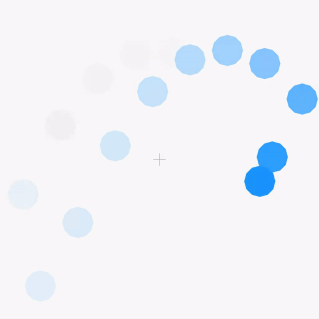
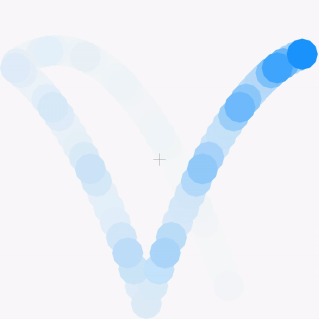
As we will discuss further below, a more creamy ADSR envelope may cash out in a more pleasant experience, whereas a sharper or spikier envelope may in turn create more harsh experiences.
Color Pulse/Negative After Images (Modifier)
The color pulse effect transforms the image’s color towards its opposite in the CIELAB color space with a given frequency. It modifies strobe, replay, and trails (in principle, there can be a different color pulse for each effect, but for now it modifies all three simultaneously).

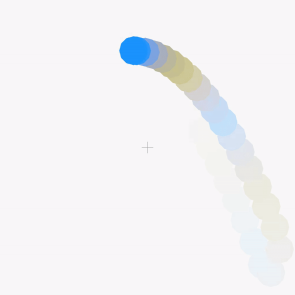
Unlike pulse, color pulse modulates the color rather than the brightness of the input. The way we determine what color to transform into is by going to the opposite side of the CIELAB color space. This accurately approximates the negative afterimage of any phenomenal color (such as yellow being the negative afterimage of blue, and green being the negative afterimage of red). In our current implementation, color pulsing affects strobe and replay quite differently. For replay, the effect is one where there are now versions of the ball (or image, more generally) that have the opposite color that are chasing the original ball, whereas for strobe the effect is that of giving a seizure to each of the recent snapshots of experience! See for yourself:
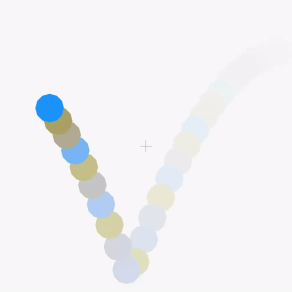

In a future version of the tracer tool, color pulse may become a sub-property of each main tracer layer in the same way ADSR is a sub-property of the strobe and replay layers.
Color pulsing may be an important piece of the puzzle for understanding how otherwise similar drugs can have such dramatically different effects. Tentatively, color pulsing showed up as a distinction between DMT and 5-MeO-DMT according to one of the persons who submitted parameters (as you can see above in the replication section). For that person, DMT produced color pulses while 5-MeO-DMT did not. Of course this is just a sample size of N=1. But it seems like an important research lead if true! After all, DMT trip reports do talk of highly colorful hallucinations that typically involve the combination of colors and their opposites (e.g. “The wall looked like a Persian carpet with an alternating checkerboard pattern design of neon green and magenta light” – anonymous 10mg DMT), whereas most 5-MeO-DMT trip reports don’t feature color very much. In fact, 5-MeO-DMT trips are often in black and white, pure white, pure black, or “nothingness color.” We discuss the implications of this in more detail in the last section of this piece (Getting Realms from Time-Like Textures).
Face Value vs. Dynamic Feedback Model
It is important to point out that the tracer tool works under the assumption of linearity between the effects it models. In other words, each effect modifies the input in its own way, and the corresponding modifications are added linearly at the end. This does not need to be the case. And in fact, we must expect the brain to have a lot of complex non-linearities where e.g. the pulsing effect is then used in a replay loop which entrains a strobing pattern which focuses your attention and so on. This complication aside, there is a lot of value in postulating the simple model first, and then adjusting accordingly when it fails to model the more complex phenomena. When we get there, once we have identified particular drugs, doses, and combinations that produce strange nonlinearities, we can then build tracer tools that explore how the parameters of particular dynamic systems can best explain the empirical data. Until then, let us start mapping out the space with this (relatively) simple linear model.
Useful Vocabulary
I would like to highlight the fact that using the tracer tool can be very educational. Familiarizing yourself with the effects and their modifications will allow you to be able to describe in detail psychedelic tracers even without having to use the tool again. For instance, I find myself now able to describe what kind of tracer effect appears on any given replication or trippy video. For example, now that you have read about them, can you tell us what is going on in the following gifs?:
The Explanatory Power of the Time-Like Texture of Experience
Exotic Phenomenal Time
We have previously suggested that tracers in the most general sense (i.e. including tracers for emotions, thoughts, and all sensory modalities in addition to visual experience) are very important for understanding the time distortions one experiences in exotic states of consciousness. The overall idea is that the aspect of our experience that gives rise to the feeling of time passing is the result of implicit causality in the network of local binding connections, which we call the pseudo-time arrow (see a recent presentation about it). Don’t worry about the details, though. All you need to know is that here we model phenomenal time as the direction along which causality flows within one’s experience. And because this is a statistical property of our experience, it turns out that phenomenal time ends up being very malleable; it admits of “exotic phenomenal time” variants:
.png)
.png)
.png)
.png)
.png)
This framework can articulate what is going on when you experience crazy psychedelic states such as moments of eternity, time branching, time looping, and so on. Now, even these are just some of the possible ways in which the network of local binding connections can give rise to exotic phenomenal time experiences. In reality, because the pseudo-time arrow emerges at a statistical level in the network, one can have all manners of local pseudo-time arrows nested in complex ways, as briefly discussed in the presentation:
I will end by speculating: I just walked you through seven types of exotic phenomenal time, but if indeed [the experience of time] can be explained in terms of causality in a graph, then there are many other exotic phenomenal times we can construct. This is especially so when we consider the space of possible hybrid phenomenal times. For instance, where in some regions in the network we may find time looping, some other region might be a moment of eternity, and perhaps another region is branching, and you know, if you have a very big experience, there is no reason why you wouldn’t be able to segment different regions of it for different types of phenomenal time. This is not unlike, perhaps, how we think of Feynman diagrams, where this part of it here is moving forwards in time, this part here is doing a loop, this part here is branching… I think a lot of the topologies we see here could be used to represent completely new [hybrid] exotic phenomenal times.
.png)
.png)
Given the diversity of ways in which phenomenal time can be expressed in an experience, I will start talking about the patterns encoded in the pseudo-time arrow as the time-like texture of experience. This way, rather than assuming that one’s sense of time is globally consistent in a given way (e.g. as in “I am fully inside a time-loop”), we can discuss how various patches and components of one’s experience have this or that time-like texture (e.g. “my visual field was looping, but my proprioception was strobing and my thoughts felt timeless”).
Drugs
As a generic effect, all psychedelics seem to increase the duration of qualia in one’s experiential field, leading to a buildup of energy. But the precise shape this takes matters a lot, and it is certainly different between drugs. An example pointed above is how LSD and DMT seem to produce strobe and replay patterns of markedly different frequencies. For DMT, the spatial and temporal frequency of the visual hallucinations is usually described as “very high.” Based on the replications thus far, along with personal reports from a musician I trust, DMT’s “characteristic frequency” seems to be in the 25 to 30 Hz range. In contrast, LSD’s frequency is more in the range of 15 to 20 Hz: both Dubois & VanRullen’s LSD tracer study and subjective reports I’ve gathered over the years point to the hallucinations of acid having this rough frequency. Hence, the very building blocks of reality of a high-dose DMT breakthrough experience consist of tiny time-loops and strobe effects interacting with one another, weaving together a hallucinated world with surprising levels of detail and intense freshness of experience (as all the time loops are “young” due to their short duration). Really, when you take a small dose of DMT and you see the walls tessellating into wallpaper groups, notice how each of the tiny “bricks” that make up the tessellation is itself a time loop of sorts! It is not a stretch to describe a DMT experience as a kind of complex Darwinian ecosystem of tiny coalition-based time loop clusters bidding for your attention (cf. Hyperbolic Geometry of DMT Experiences).
Taking this paradigm seriously allows us to interpret psychoactive effects at a high level in novel ways. For example, these are some of the general patterns we have identified so far:
- Psychedelics tend to have strong replay and strobe effects
- HPPD, cannabis, and dissociatives seem to have a much smoother trail effect
- MDMA and 5-MeO-DMT have characteristically creamy ADSR envelope effects
Using the sound metaphor to restate the above, psychedelics introduce beats and recursion, dissociatives introduce reverb, and empathogens/valence drugs may affect the temporal blur of one’s experience. Thus, we arrive at a model of psychoactive substances that makes sense of their effects in the language of signal processing rather than neurotransmitters and functional localization. This sheds a lot of clarity on the mysterious and bizarre state-spaces of consciousness disclosed by psychoactive drugs and paves the way for a principled way of predicting the way drug combinations may give rise to synergistic effects (more on that below). More so, it lends credence to the patternceutical paradigm of drug effects.
Meditation: Insight and Concentration Practices
The pseudo-time arrow paradigm suggests that one of the ways in which meditative practices can switch one’s state of consciousness is by disrupting sober time-like textures and enabling exotic time-like textures not available to the sober mind (see also: The Neuroscience of Meditation: Four Models (Johnson 2018)). My personal experience with meditative practices is limited, but I’ve had the pleasure of experiencing some strange effects so far. In particular, I would say that concentration practices seem to give rise to experiences with long and stable pseudo-time arrows – a peacefulness in which nothing is happening yet the flow of time is constant and rather uneventful. The phenomenal time of highly focused states of mind may be full of reverb, but I do not think it has crazy time loops. Moments of eternity and timelessness may be present at the limit here (e.g. moments of eternity and Jhanas may be deeply connected), though I will need more personal experience to say this with confidence.
On the other hand, insight practices such as 8 may have more of a replay and strobe effect. In particular, this may happen as a result of three core effects from this kind of meditation: (1) it stops you from dissipating energy across long narratives, (2) it recaptures the energy you were going to use for a longer narrative to feed the noting process instead, and (3) it entrains the rhythm of noting. This in turn (a) energizes a regular constant-frequency pattern (the frequency of noting) and (b) reduces the energy of every other rhythm, which in turn (c) canalizes sensory stimulation energy towards the brain’s noting frequency and all of its harmonics, which eventually leads to a high-frequency energized state of consciousness whose building blocks are tiny time-loops. These can synchronize and create experiences with characteristic time-like textures made up of such tiny energized loops. Hence, noting practice above some level of skill (e.g. with a noting frequency above 3 Hz) can be DMT-like to an extent (in light of thinking of DMT realms as made up of energized high-frequency mini-time-loops).
These experiences characterized by intense tracer effects are in a similar space as the strange temporal distortions that happen when you are dizzy (like when you stand up too fast or hyperventilate). The “loss of context” that results from this effect is due to the longest replay loops becoming too short to contain the necessary information to “keep you in the loop about what is going on.” Hence the confusion about who or what you are, what you are doing, and how you got here that happens when you are near passing out from standing up too quickly. That confusion takes place in an otherwise highly detailed and intense high-energy and high-frequency “rush” made of tiny time loops.
Thus, one of the gateways into altered states of consciousness via meditation with noting can be summarized as what happens when you induce a self-reinforcing pattern of strobing, replay, and pulsing that fully captures your attention. This process builds up a lot of energy, which one can only wield up to a point. When one fails to control it, the state decays into a series of tracer patterns that use the clean loop as its background reference. As this happens, one experiences a world whose building blocks are beautiful tiny jewels of attention, slowly decaying as one loses the ability to stay focused. The decay process also seems to do something good when properly orchestrated. Namely, as the decay process begins, one naturally experiences a Cambrian explosion of qualia critters eager to feed off of the negentropy generated, as thought-forms need attention to survive. This whole process, one could argue, lends phenomenological credence to the paradigm of neural annealing, where one’s brain uses a heating and cooling schedule to entrain brain-wide harmony.
In other words, with something like a noting practice, one ends up creating a world simulation whose building blocks are all embedded in a very tight time-loop, a wind-up universe of concentrated awareness. Perhaps we are going too far with this explanation. Either way, we really feel that thinking in terms of these generalized tracer dynamic patterns is an exciting new conceptual toolkit that allows us to describe the quality of exotic experiences that were hard to pinpoint before.
Three Exciting Possible Applications of the Tracer Tool: High-O-Meter, Synergy Quotient, and Harmonic World-Building
High-O-Meter
How high are you? It is often difficult to put a number on this question. But once we have established the parameters for different drugs (e.g. characterized DMT as living in a region of the parameter-space that is of higher frequency than LSD, etc.) we can show a series of gifs to someone and ask them to point at the one that best shows what tracers looked like at the peak of their experience. This way we can quickly estimate how high they got (at least visually) with a very simple question.
For example, we may find that the “modal response” to 50, 100, 200, and 300 micrograms of LSD looks as follow:


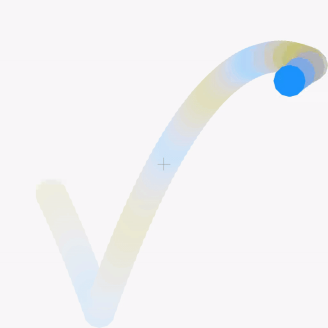

If this works, we would be able to sort research participants into one of these ranges just by asking them to point at the image that best captures their experience. Similar tools for other modalities could be used to obtain a global “highness score” meaningful across people.
Synergy Quotient (orthogonality vs. synergy vs. suppression vs. harmonization)
What happens when you combine psychoactive drugs together? We have previously discussed in great detail what happens when you take combos of drugs from various categories (see: Making Amazing Recreational Drug Cocktails), but admit that there are huge puzzles and unknowns in this space. Of note is that some combinations give rise to synergistic effects (e.g. psychedelics and dissociatives), others blunt each other’s action (e.g. agmatine and nootropics), while yet others seem to create competing effects due to some kind of mutually-exclusive qualities of experience (e.g. salvia and DMT, a.k.a. “drugfights”). For an illustrative example of the third category, famous psychonaut D. M. Turner reports:
I smoked 30 mg. of DMT in three tokes, followed immediately by 650 mcg. of Salvinorin that I had preloaded in a separate pipe.
The effects were felt almost immediately. The first thing I noticed was a grid of crosshatch patterns. I had perceived something similar when using 2C-B with mushrooms, which I believed to be the result of using two psychedelics that were not compatible with each other. However, in this case the patterns were defined to a much sharper degree, and it seemed apparent that these two substances affect consciousness in differing ways that are not synchronistic when used together. Both the Salvia and DMT entities seemed to have been taken entirely off guard and had not been expecting this confrontation. These entities seemingly paid no attention to me as their attention was entirely fixed on each other. It soon became apparent that the two were going to battle, vying to determine who would have control of my consciousness.
D.M. Turner – 650 mcg. Salvinorin with 30 mg. N.N. DMT(Turner 1996)
We think that the tracer tool can be useful to quantify the degree of interaction between two drugs. For instance, say that drug A produces a robust 10 Hz replay effect, whereas drug B produces a 7 Hz Strobing effect. Would drug A + drug B cause a tracer that blends these two facets, or does it produce something different? If the combination’s tracers are different than the sum of its parts, how large is this difference? And can this difference be identified with a particular recursive stacking of effects, or as the result of a nonlinear interaction between dynamic systems? We believe that this line of research may be very illuminating.
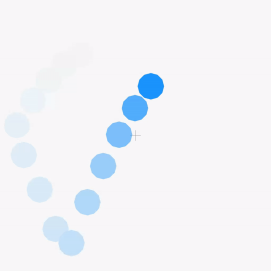
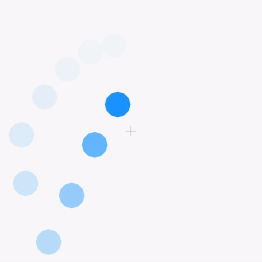
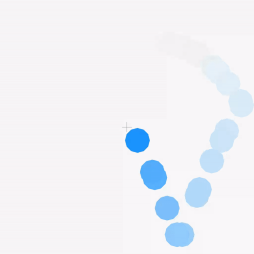
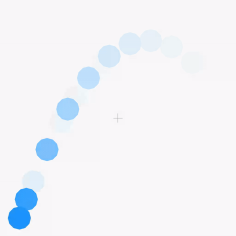

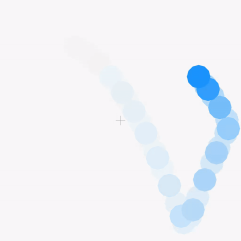
In the above example, we show what various possibilities for the result of drug combos may be. “Orthogonal” effects mean that the resulting tracer is the sum of the tracers of each drug, “suppression” means that one drug’s effect reduces the effect of the other, “synergy” means that the resulting effects are stronger than you’d expect by just linearly adding the effects of each drug, and “harmonization” refers to the possible slight-retuning of the characteristic frequency of each drug’s effect that allows for a consonant blending. How strongly the combo is from the predicted effect based on each drug would determine the synergy quotient of the pair.
A few possible (tentative) examples: alcohol + psychedelics give rise to orthogonal effects, opiates and psychedelics result in effect suppression, dissociatives and psychedelics result in strong synergy (not unlike what you get when you stack reverb and looping in music), and MDMA and psychedelics might result in harmonized tracers (hence the creamy and harmonious visuals of candy-flipping). We would love to see research tackling this question.
Harmonic World-Building
Tinnitus is usually loud and distracting, but in addition, it can also be annoying and unpleasant. At QRI, we posit that the precise pattern of tinnitus—not only its loudness—has implications for how bad it is for someone’s mental health: dissonant and chaotic tinnitus might be worse than consonant and harmonious patterns, for instance.
In a similar vein, we think that the particular tracer patterns, over and above just their intensity, of perceptual conditions like HPPD probably matter for how the condition affects you at a cognitive, perceptual, and emotional level. Concretely, we would like to study how valence is related to one’s particular tracer patterns: we think that when psychedelic tracers feel good, that such positive valence may show up in the form of (a) harmonious relationships between the components of the effects, and (b) a sort of creaminness in the way the tracers come over time (as shown in the MDMA + LSD trip report by Steven Lehar).
We take seriously the possibility that something akin to the rules of harmony in music (see: Tuning Timbre Spectrum Scale by William Sethares) will have a showing in the way resonance in any experiential field cashes out into valence. In other words, the way patterns of resonance in the brain combine might be responsible for whether the experience feels good or bad. In particular, under psychedelics and other high-energy states of consciousness, one’s visual field is capable of instantiating visions of both tremendous beauty and tremendous terror. It is as if in high-energy regimes, one’s visual field acquires the capacity for creating pleasure and pain of its own (albeit “visual” in flavor!). While sober, one can get something akin to this effect, though only mildly in comparison: you can experience beautiful patterns by staring at a smooth strobe with eyes closed, or experience unpleasant reactions when the strobe shines at irregular intervals. The quality of the self-generated light-show in energized states of consciousness (such as a psychedelic experience) will likely have an impact on one’s sense of wellbeing. Is one’s inner light show all irregular, uncoordinated, sharp, and jarring? Or is it smooth, clean, robust, and soft? Based on the Symmetry Theory of Valence, one can anticipate that one’s tracer phenomenology feels good when it expresses or approximates regular geometries and bad when the implied geometries are irregular or disjointed.

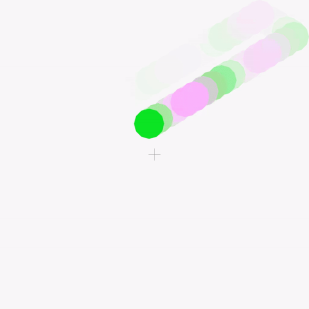
The creaminess of smooth ADSR envelopes would likewise prevent sensory and emotional dissonance by virtue of softening spikes of sensations. This, of course, is ultimately an empirical question. Let’s investigate it!
Final Thoughts: Getting Realms from Time-Like Textures
The complexity and information content of one’s state of consciousness as induced by a substance may depend on what fits in the repertoire of time-like textures of the state. For example, some states might be much more prone to generate quasi-crystals as opposed to crystals, as we argued in DMT vs. 5-MeO-DMT(Gómez-Emilsson 2020).
What are these crystals? One of the characteristic spatial effects of psychedelics is that they lower the symmetry detection threshold. This gives rise to the beautiful tessellations (at times Euclidean, at times hyperbolic(Gómez-Emilsson 2016)) everyone talks about. Analogously in time, psychedelics are notorious for creating time loops (cf. Going Loopy(Alexander 2014)). In a deeper sense these are, we might argue, two facets of the same underlying effect. Namely, the creation of, for lack of a better term, qualia crystals. We can be cautious about assigning an ontological interpretation to qualia crystals; all we are proposing here is to accept them as phenomenological artifacts that tie together a lot of these experiential qualities. These gems of qualia come in many flavors, but they all express at least one symmetry in a clean and deep way. Whereas our experience of the world is usually made of a complex distribution of (tiny) qualia crystals which form the macroscopic time-like texture of our mind, we find in exotic states of consciousness the possibility of experiencing the refined, pure version. Timothy Leary in The Psychedelic Experience describes what he believes is the key existential conundrum close to the peak of an ecstatic trip:
Is it better to be part of the sugar or to taste the sugar?
Timothy Leary, Richard Alpert, and Ralph Metzner in The Psychedelic Experience
In line with the neural annealing frame(Johnson 2019), there is a very real sense in which slightly past the peak of a psychedelic experience you will find some of the largest, purest, most refined qualia crystals (at least relative to the human norm). And what this looks like will depend a lot on what the available building blocks are! The diversity of these building blocks makes the time-like texture of experience triggered by different drugs dramatically variable.
Some of the realms of experience are made with a time-like texture of interlocking time loops of different frequencies allowing you to experience the sense of “a big other.” In some other realms, the time loops are all aligned with each other, which makes self-other distinctions hard to represent and reason about. The various flavors for the felt sense of non-duality, for example, may correspond to different ways in which strobes, replays, pulse, etc. align perfectly to dissolve the internal boundaries used as building blocks to represent duality. At the extreme of “unification,” such as the state found in the 5-MeO-DMT breakthrough, one “becomes” a metronome whose tune is reflected faithfully everywhere in one’s experience, such that there is nothing else to interface with. Hence, one becomes “invisible to oneself.” To be in a state of near total oneness may entail the feeling of nothingness for this reason (thus the highest Jhanas being “nothingness” and “neither nothing nor something”).
This overall interpretative frame of exotic states as the result of time-like textures may show up empirically, too. One of the exciting early results, as mentioned above, is the report that while DMT creates complex positive and negative after-image dynamics full of color and polarity, the tracers on 5-MeO-DMT are monochromatic, meaning that one only experiences their positive after-image.
This alone may go a long way in explaining why the visual character of these two drugs is so distinct at their upper ranges. Namely, because DMT gives rise to complex checkerboard grid-patterns of overly-saturated colors intermingling with their polar opposites, whereas on 5-MeO-DMT, one often experiences an incredibly bright white light, or even a sense of translucid empty space, but no colors! The paradigm of using tracer patterns to make sense of states of consciousness would here suggest that a “breakthrough” experience can be interpreted as what happens when one’s world is saturated with the time-like texture characteristic of the tracer pattern of either drug. The realms of experience these agents disclose are the universes that you get when the building blocks of reality are those specific time loops and attention dynamics, leaving no room for anything that does not follow those “phenomenal time constraints.” When the dose is low, this manifests as just a gloss over one’s otherwise normal experience, a mere modifier on top of one’s sober reality. But when the dose is large, these time loops and attention dynamics drive the very way one’s mind constructs our whole sense of the world.
In this light, rather than thinking of exotic states of mind as places (as the “realm” metaphor alludes to), one can imagine conceptualizing them as ways of making sense of time. When you smoke salvia, you make sense of time in a salvia kind of way, which involves looping back chaotically in a way that typically results in losing the normal plot altogether and instead exotic narratives better fitted for the salvia attentional dynamics end up dominating the world-building process of the mind. Hence you end up in “salvia land.” Which is what you remember best. But the salvia land one ends up in is only a circumstantial part of the true story. The fundamental generator that is upstream of this realm would be the overall tracer pattern, the time-like texture of the experience: the neuroacoustic effect of salvia. He who controls the time-like texture of experience, controls the world-building process of the mind. Thus the paramount importance of understanding tracer patterns.
Do you want to collaborate on this project?
For Researchers
The Tracer Replication Tool is the first of a series of research tools we are creating at QRI specifically designed with psychedelic phenomenology in mind. The spirit of this enterprise is to identify the ways in which psychedelic states of consciousness can enhance the information processing of the mind in some ways. Rather than focusing on how information processing is impaired, we develop these tools with the goal of finding the ways in which it is enhanced (cf. psychedelic cryptography(Gómez-Emilsson 2015), psychedelic problem solving(Harman and Fadiman 1996)). We take very seriously high-quality trips reports from rational psychonauts, which help us ideate tasks that are likely to show large effect sizes. Thus, rather than bringing traditional psychometric tools to the psychedelic space, we think that developing the tools to assess the psychedelic state in its own terms is more likely to provide novel and significant insights. We would love to have academic researchers include some of these tasks in their own study designs. Becoming familiar with the Tracer Replication Tool takes less than 10 minutes, and based on the pilot results, operating it during a psychedelic experience is possible for a good fraction of people under the influence of these substances. It would be amazing to have tracer replications included in psychedelic studies to come. If you are involved in psychedelic research and would like to use the Tracer Replication Tool or learn more about the toolkit we are developing please reach out to us! We would love to hear from you.
For Participants and Volunteers
There are several ways you can help this project. As a beta tester participant, you can use the tracer tool to replicate tracers that you yourself have experienced. There are three categories here (which you can specify at the point of submission when using the tool):
- Retroactively: If you have experienced visuals tracers in the past and think you can remember them accurately (or at least recognize them when you see them), you can play with the Tracer Replication Tool and submit the parameters that best match your memory of the tracers you experienced.
- Post-Trip: If you are planning on taking a psychedelic in the near future3 and want to submit a datapoint from your experience, open the tracer tool during the trip and look at the bouncing ball (and other animations). While staring at the center of the animation for about a minute, try to get a clear picture of what the tracers look like. We encourage you to play with the color, speed, and animation type while you are in the state so that you see how tracers react to different visual inputs. Then as soon as possible after the trip is over, come back to the tool and find the tracer parameters that best replicate what you saw.
- Within Trip: If you are familiar with the tracer tool parameters so that you can tell in real time whether you are experiencing strobing, replays, color pulsing, etc. then you may want to try to replicate the tracers you are seeing in real time. We recognize that this has the problem that the tracer replications will have psychedelic tracers of themselves, and that they get in the way of the tracers you are trying to reproduce. That said, the early reports we have received state that it is actually easier to do a good job at replicating the tracers while in the state than after it. So we also welcome submissions of this type.
The case of HPPD and other non-drug induced tracers could be considered in this frame as well. For instance, we have been made aware that during the meditation practice of Fire Kasina, one experiences many pronounced tracers of various kinds. Thus, if you are currently experiencing meditation-induced tracers, you can submit parameters of the within trip kind. If you saw the bouncing ball (or other animations) during the meditation but have now exited your state, then you could submit a datapoint of the post-trip kind. And if you only have the recollection of tracers but did not see the ball at the time, then submit a retroactive datapoint. Likewise, HPPD and other tracer phenomena may come and go and their intensity may wax and wane, so these categories are also useful in such cases.
Please sign up to the QRI mailing list if you want to stay informed about the development of QRI’s Psychophysics Toolkit. We also want to emphasize, as we note in the Special Thanks section below, that this tool could not have been made without our amazing QRI volunteers. We are very eager to work with anyone with technical skills useful for this and related projects. If you would like to help us build these tools and advance our collective understanding of exotic states of consciousness, please get in touch. For more QRI volunteer projects see our volunteer page.
Acknowledgements
Special Thanks to: Lawrence Wu for implementing the current version of the tool. To Andrew Zuckerman, Quintin Frerichs, and Mike Johnson for a lot of useful ideas, conversations, and keeping the project afloat. To Robin Goins and Alex Zhao for getting a head start in implementing an earlier version of the tool. To the QRI team for encouragement and many discussions. And to the anonymous rational psychonauts and the HPPD sufferer for contributing pilot data with visual replications of their own experiences.
Tags
Consciousness, Psychedelic, STV, Valence, Research, Psychophysics, Psychedelic Cryptography
A significant message of the book is that it is useful to conceptualize these rhythms as being the result of endogenous pattern-generating networks specialized to create specific frequencies, envelopes, and types of synchronization.↩︎
“There are only two sources that control the firing patterns of a neuron at any time: an input from outside the brain and self-organized activity. These two sources of synchronization forces often compete with each other (Cycle 9). If cognition derives from the brain, this self-organized activity is its most likely source. Ensemble synchrony of neurons should therefore reflect the combination of some selected physical features of the world and the brain’s interpretation of those features. Even if the stimulus is invariant, the brain state is not. From this perspective, the most interesting thing we can learn about the brain is how its self-generated internal states, the potential source of cognition, are brought about. Extracting the variant, that is, brain-generated features, including the temporal relation between neural assemblies and assembly members, from the invariant features evoked by the physical world might provide clues about the brain’s perspective on its environment. Yes, this is the information we routinely throw away with stimulus-locked averaging.”(Buzsáki 2006)↩︎
Disclaimer: We are not encouraging anyone to ingest psychoactive substances.↩︎